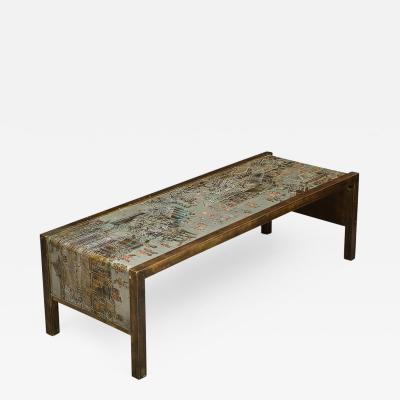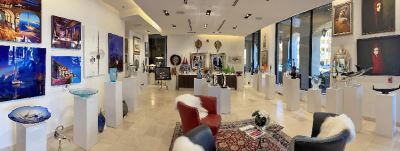American Redware
Much of redware’s appeal stems from its earthy, rustic appearance, attracting a broad range of collectors, from folk art enthusiasts to those interested in contemporary design. People are drawn to redware’s associations with traditional forms and decoration and to the connection it offers to the lives of early settlers, embodying stories that cut across economic and social lines. The availability and variety of redware have also made this an ever-popular area of collecting.
With the settlement of the first colonies in the seventeenth century, people required basic household utilitarian wares, and imported redwares fulfilled that need. By the second half of the century, potters were producing redware from local clays, augmenting the redware from abroad, and continuing a tradition that extended back to at least Roman times. Early colonial potters generally produced copies of familiar, traditional German, English, Dutch, and French forms. By the middle of the eighteenth century, American redware production had spread throughout the eastern seacoast, from the largest cities to the most rural communities. While some redware forms such as molded teapots were seemingly influenced by expensive imported silver prototypes, redware was primarily produced in utilitarian forms used by householders at all economic levels (Fig. 1). Redware production continued at a steady pace well into the mid-nineteenth century, even though the introduction of stoneware and other materials such as tin and glass presented new options for household wares, particularly in the more urban centers. Through the ensuing years, choice of other materials further diminished the dependency on redware,which largely fell out of favor by the 1880s because of competition from mass-marketed goods.
The chief output of American potteries seems to have been jugs, crocks, bowls, pitchers, pots (Fig. 2), and plates, but a great variety of shapes and forms exist. Bottles, jars, teapots, sponge cake molds, candleholders, chamber pots, fat lamps and stands, banks, flower pots, hanging vases, inkwells, water pipes, roofing tiles, and a host of hand-modeled toys, whistles, and items of an ornamental nature all attest to the skill and imagination of the potter. A sentiment occasionally found on Pennsylvania German pottery reflects the versatility of the craft: Aus der Erde mit Verstand macht der Heffner alle hand (Out of the earth, with understanding, the potter makes most everything).
Redware Manufacture
Redware, or red earthenware, is a clay-bodied ware heated in a low-fired kiln at 1,700 to 1,800 degrees Fahrenheit; higher temperatures would melt the clay. Other earthenwares such as the yellow and white variety are made from clay composed of different mineral deposits; they are fired at higher temperatures and are impervious to liquids. Redware, however, has a porous clay body made impermeable only by the use of a glaze, typically lead-based. The lead in the glaze may have resulted in shortened life spans for potters and was perhaps unhealthy for patrons as well. While consumers and producers may well have been aware of the risks, many had no available alternatives.
The clays needed for redware production are found in much of the United States. Whether the clay is gray, blue, yellow, or red when dug from the ground, the iron deposits in the clay turn it the characteristic color of red when fired. At times this color varies from a red-brown to orange, depending on firing temperature and mineral content of the clay.
A potter needed few tools: a potter’s wheel, which he could fashion on his own; red lead oxide for glazes that, until the discovery of domestic mineral deposits in the early nineteenth century, had to be attained from abroad or be melted from the lead foil wrapping that contained imported tea; and a kiln constructed of local stones or brick encased with iron bands for added strength.
The establishment of a pottery in newly settled communities was a welcomed event. The demand for wares is exemplified in the Moravian records of Salem, North Carolina, where in 1761 “people gathered from 50 and 60 miles away to buy pottery but many came in vain, as the supply was exhausted by noon.”1
Most of the hollow ware pottery produced in America during the eighteenth and nineteenth centuries, such as jugs and pots, was thrown or turned on the wheel. Toys and whistles might have been shaped by hand, and items such as teapots were frequently cast in molds. Plates were generally rolled out with a rolling pin to the desired thickness, depending on the diameter desired for the finished piece. Disk-shaped pieces of clay were cut out and then put over a ceramic or wooden mold. After trimming off the excess clay, the newly shaped plate was coggled on the rim with a wooden wheel that left a decorative trail. This finished edge was intended to reduce flake size when the plate was chipped.
Decoration
The great demand for redware left little time for potters to embellish their products. When decorations were employed, it meant more time, which translated to a more expensive object. The majority of American pieces were simply covered with a transparent lead glaze to seal the surface; the addition of mineral-based colorants such as copper oxide for green or manganese for black provided a decorative element (Figs. 2, 3). Beyond glazes, there were several ways in which an object could be decorated: Simple surface incising was added during the final revolution on the wheel; decoration might be impressed by the use of a metal or wooden stamp; separately shaped or cast elements were applied; some objects were sponge-decorated; wares were dipped in a bath of watered-down clay called “slip,” hence the term slip-wares (Fig. 1); some were embellished with slip-trailed designs; and a relatively small group was decorated in the sgrafitto tradition.
Regionalism
Regrettably, very few potters signed their wares, leaving a vast body of work but very little information relating to specific locations and time periods of manufacture. For example, some five hundred redware potters have been documented in the Berks-Lancaster area of southeastern Pennsylvania; of these, less than twenty signed or stamped their work with any regularity. Overall, less than one percent of redware is marked (Fig. 1).
Because there is so little redware documented to makers, it is often categorized in broad regional terms based on forms, glazes, clay bodies, and decorative techniques. The major American redware centers stretched from Maine to North Carolina and west to Ohio. Distinguishing the origin of common wares is challenging, because some forms are relatively consistent throughout the regions. Decorative wares, however, can often be associated with distinct production areas. The redwares of the Shenandoah Valley (Fig. 9), for instance, are often covered in a distinctive yellow/white glaze with haphazard green and brown splotches, and slip-trail decorated redwares are usually associated with North Carolina, Pennsylvania, New Jersey, and Connecticut (Fig. 10).
Collecting Tips
A collection of redware can be assembled based on forms, decorative elements and glazes, region, maker, or time period. Redware is an exceptional investment at all price levels as it is a part of our American heritage. Redware items, such as an ovoid New Jersey jug with black glaze or sponge-decorated wares from Connecticut or Virginia, can be purchased for between $200 and $500. Wares decorated with slip-trail designs can be acquired in a range of $500 to $5,000, depending on rarity and complexity of design. Seasoned collectors strive to acquire grander examples, often more ornately decorated or of unusual form. Prime redware pieces such as Pennsylvania sgrafitto plates (Figs. 7, 8) or rare figural forms made by the Moravian potters at Salem and Bethabara, North Carolina, will bring $10,000 to more than $50,000.
As always, condition is a key factor in determining value. If a piece has been broken, reglued, or has extensive cracks or chips, the value may be half that of a piece in prime condition. Glaze loss because of use is another factor that decreases the value of a piece. However, exceptions can be made when an object is exceedingly rare or the possibility of finding another example is minimal.
As redware rises in popularity, contemporary potters are making accurate replicas, identifying their wares with deeply impressed marks. But those who intend to deceive will grind down marks and give objects the appearance of age by chipping edges and blackening the bottoms.
New collectors can educate themselves on redware by reading the available literature and by examining as many examples as possible through visits to museums, private collections, or dealers, where the objects can actually be handled. Collectors should study the designs, types of rims, shapes of handles, glazes, and decorative elements, for example. Time spent developing a sense for what is appropriate to a period and region will result in refined connoisseurship skills and make for a stronger redware collection.
Greg K. Kramer is owner of Greg K. Kramer & Co. in Robesonia, Pennsylvania. A dealer with over thirty years of experience, he specializes in Americana, folk art, and period and painted furniture, assisting in the building and refining of collections. Lester P. Breininger, Jr., is a ninth generation Pennsylvania German and a potter since 1965, with works represented in the collections of the Smithsonian, Winterthur, and the Philadelphia Museum of Art. He is an ardent collector of redware and author of numerous publications on the decorative arts of the Pennsylvania Germans.
All images, unless noted, courtesy of Greg K. Kramer & Co.
Bivins, John, Jr. The Moravian Potters in North Carolina (Chapel Hill, NC: University of North Carolina Press, 1972).
Corbett, Cynthia Arps. Useful Art: Long Island Pottery (Setauket, Long Island, NY: Society for the Preservation of Long Island Antiquities, 1985).
Cullity, Brian, ed. Slipped and Glazed: Regional American Redware (Sandwich, MA: Heritage Plantation of Sandwich, 1991).
James, Arthur E. The Potters and Potteries of Chester County, Pennsylvania (West Chester, PA: Chester County Historical Society, 1945).
Ketchum, William C. American Redware (New York: Henry Holt & Company, 1991).
Lasansky, Jeanette. Central Pennsylvania Redware Pottery (Lewisburg, PA: The Union County Oral Tradition Projects, 1979).
Rice, A.H., and John B. Stoudt. The Shenandoah Pottery (Strasburg, VA: Shenandoah Publishing House, Inc., 1929).
Watkins, Lura Woodside. Early New England Potters and Their Wares (Cambridge, MA: Harvard University Press, 1950; reprinted, Hamden, CT: Archon Books, 1968).
Wiltshire, William E. Folk Pottery of the Shenandoah Valley (New York: E.P. Dutton, 1975).
Winton, Andrew L. and Kate B. Norwalk Potteries (Canaan, NH: Phoenix Publishing, 1981).

















.jpg)

















